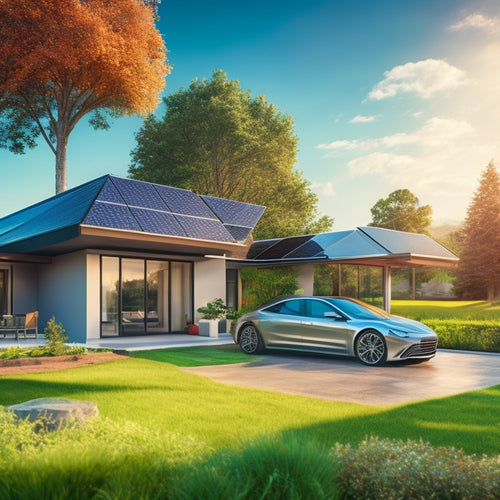
Solar Panel Roof Mounting Systems for Residential Use
Share
When selecting a solar panel roof mounting system for your residential property, you'll need to take into account various types of mounts, including fixed, adjustable, and tracking systems. Roof penetration vs. non-penetration methods, as well as roof size and orientation, affect system performance and installation. Load calculations and structural integrity assessments are essential to guarantee your roof can support the weight of the panels. In addition, you'll want to evaluate factors like material selection, environmental impact, and local building codes to choose the right system for your needs. As you weigh your options, you'll find that understanding these key considerations is just the starting point for a successful solar panel installation.
Key Takeaways
- Residential solar panel roof mounting systems come in various types, including fixed, adjustable, and hybrid solutions, each with its own benefits and limitations.
- Roof size, orientation, and pitch are crucial considerations for optimal energy production, with south-facing roofs receiving the most direct sunlight.
- Load calculations and structural integrity assessments are necessary to ensure the roof can support the weight of solar panels and components.
- The choice of mounting system depends on factors such as mounting material, environmental impact, local building codes, durability, and cost considerations.
- Popular brands like Unirac, IronRidge, and SnapNrack offer durable and adjustable mounting systems, with each brand having its own strengths and weaknesses.
Types of Solar Panel Mounts
Among the numerous solar panel roof mounting systems available, selecting the right type of mount is essential to guarantee a secure and efficient installation.
You'll need to take into account factors like compatibility, installation tools, and maintenance requirements. Fixed mounts, for instance, provide a cost-effective solution, but they can't be adjusted to optimize energy output.
Adjustable mounts, on the other hand, allow for seasonal adjustments to maximize energy production. If you're looking for a more versatile option, ground mounts can be installed on the ground or on a roof.
Solar racks and tracking systems offer hybrid solutions that combine the benefits of fixed and adjustable mounts. When choosing a mount, don't forget to take into account aesthetic options, as they can impact the overall appearance of your solar panel system.
You'll also want to verify that your chosen mount is compatible with your roof type and size. By selecting the right mount, you'll be able to reap the benefits of solar energy while minimizing installation and maintenance costs.
Roof Penetration Vs. Non-Penetration
Your roof's structural integrity is a top priority when installing a solar panel roof mounting system.
When deciding between roof penetration and non-penetration systems, you must consider the type of roof you have. For instance, asphalt shingle roofs and metal roofs may require different installation approaches. Weather considerations, such as wind resistance and insulation impact, also play a significant role in the decision-making process.
Non-penetration systems, which don't breach the roof's surface, are ideal for roofs with complex angles or multiple skylights. On the other hand, penetration systems, which involve drilling into the roof, may be more suitable for simple roof types.
Installation materials, maintenance practices, and aesthetic preferences also influence the choice between penetration and non-penetration systems. Additionally, building codes, long-term durability, and cost differences must be taken into account.
Advantages of Roof Mounting Systems
When you choose a roof mounting system for your solar panels, you'll benefit from an easy installation process that minimizes disruptions to your daily routine.
Moreover, you can expect a significant increase in your property value, making your home more attractive to potential buyers if you decide to sell in the future.
In addition, you'll enjoy energy savings that are guaranteed, providing a clear return on your investment.
Easy Installation Process
With solar panel roof mounting systems, you're just a few steps away from utilizing renewable energy. The installation process is designed to be straightforward and efficient, allowing you to start generating power quickly. You'll need some basic installation tools, such as a drill, wrench, and screwdriver, to secure the mounting system to your roof.
Here is a breakdown of the installation process:
| Step | Description |
|---|---|
| 1 | Attach the mounting system to your roof using the provided installation tools |
| 2 | Secure the solar panels to the mounting system, guaranteeing a snug and even fit |
| 3 | Connect the panels to an inverter, which converts DC power to AC power for your home |
Some DIY tips to keep in mind:
- Verify your roof is structurally sound and can support the weight of the solar panels
- Follow the manufacturer's instructions for installation and maintenance
- Consider consulting with a professional if you're not comfortable with heights or electrical connections
Increased Property Value
By integrating a solar panel roof mounting system, homeowners can greatly enhance their property's value. This is because solar panels are a desirable feature that many homebuyers are looking for, increasing property appeal and market demand.
In fact, according to the National Renewable Energy Laboratory, homes with solar panels sell for up to $15,000 more than similar homes without them.
Here are some key benefits of increased property value with solar panel roof mounting systems:
-
Increased Resale Value: A solar panel roof mounting system can recoup its cost and even increase the resale value of your home.
-
Competitive Advantage: In a competitive real estate market, a solar-powered home can stand out from the rest, attracting more potential buyers and giving you an edge over similar properties.
-
Long-Term Investment: Solar panels can last for decades, providing a long-term increase in property value and a strong selling point for potential buyers.
Energy Savings Guaranteed
A typical rooftop solar panel installation can save you a substantial amount on your electricity bills. By utilizing the sun's energy, you'll reduce your reliance on the grid and lower your energy consumption. This translates to significant savings on your monthly bills, which can add up to thousands of dollars over the system's lifespan.
Roof mounting systems are designed to maximize energy efficiency, ensuring you get the most out of your solar panels. By optimizing the angle and orientation of your panels, these systems allow you to generate more electricity and reduce your carbon footprint.
Additionally, many governments offer financial incentives for homeowners who invest in solar energy, such as tax credits and rebates. These incentives can help offset the initial cost of the system, making it more affordable and increasing your return on investment.
With a roof mounting system, you can enjoy the benefits of renewable energy while saving money and reducing your environmental impact.
Factors Affecting Mounting System Choice
You're faced with numerous options when selecting a solar panel roof mounting system, and the choice ultimately depends on several key factors. As a homeowner looking to utilize the power of solar energy, it's essential to evaluate the following factors to guarantee you choose the right mounting system for your residential solar panel installation.
- Mounting material selection: The type of material used for the mounting system can greatly impact the overall cost, durability, and environmental impact of your solar panel installation.
For instance, aluminum mounting systems are lightweight, corrosion-resistant, and eco-friendly, while steel systems offer superior strength and durability.
- Environmental impact: The mounting system you choose shouldn't only minimize its own environmental footprint but also secure the long-term sustainability of your solar panel installation.
Reflect on the system's carbon footprint, recyclability, and potential for reuse or repurposing at the end of its life cycle.
- Local building codes and regulations: Verify that your chosen mounting system complies with local building codes, regulations, and standards.
This is vital to avoid costly rework, guarantee safety, and maintain the integrity of your solar panel installation.
Roof Size and Orientation Considerations
Roof size and orientation play a critical role in determining the ideal solar panel roof mounting system for your residential installation. You need to take into account the size and orientation of your roof to guarantee maximum energy production.
A larger roof provides more space for solar panels, but you'll also need to take into account roof shading, which can greatly impact energy output. Even partial shading from trees, vents, or skylights can reduce energy production, so it's crucial to evaluate your roof's solar access.
When evaluating your roof's orientation, you'll want to take into account the direction it faces. A south-facing roof receives the most direct sunlight, making it ideal for solar panels.
East- and west-facing roofs can also work well, but north-facing roofs receive less sunlight and may not be suitable. Additionally, you'll need to take into account the roof's pitch and angle, as these factors can affect the installation and performance of your solar panel system.
Load Calculations and Structural Integrity
You'll need to perform a roof load analysis to determine the weight capacity of your roof, considering factors like snow loads, wind loads, and dead loads.
This analysis will inform your structural assessment, which must meet local building codes and ascertain the roof can support the added weight of solar panels.
Roof Load Analysis
How much weight can your roof realistically handle before it becomes a liability? When it comes to installing solar panels, this is an important question to answer.
A thorough roof load analysis is essential to guarantee that your roof can support the weight of the solar panels, mounting system, and other components.
To determine your roof's load capacity, you'll need to take into account several factors, including:
-
Roof material compatibility: Different roofing materials have varying weight capacities. For example, asphalt shingles can support less weight than metal or clay tiles.
-
Load distribution analysis: The weight of the solar panels and mounting system must be distributed evenly across the roof to prevent stress concentrations and potential failures.
-
Structural integrity: The roof's underlying structure, including the rafters, trusses, and beams, must be able to support the added weight without compromising its integrity.
Structural Assessment Requirements
Compliance with structural assessment requirements is crucial for guaranteeing the safe and reliable operation of your solar panel roof mounting system. You need to verify that your roof can support the added weight of the solar panels, mounting hardware, and other components. This involves load calculations to determine the maximum weight your roof can handle.
A structural assessment will evaluate the load distribution on your roof, considering factors like wind, snow, and seismic loads. You'll need to evaluate the structural materials used in your roof's construction, such as wood, steel, or concrete.
The assessment will also examine the roof's original design, age, and condition to identify potential weaknesses. This information will help you determine the best placement and configuration of your solar panel system, guaranteeing that it doesn't compromise the structural integrity of your roof.
Installation Methods and Best Practices
During the solar panel roof mounting system installation process, it's vital to select the most suitable method for your specific project requirements.
You'll need to take into account factors like roof type, size, and layout, as well as local building codes and regulations. This will guarantee a safe and efficient installation that meets your energy needs.
When it comes to mounting techniques, you'll need to choose between rail-based, rail-less, and shared-rail systems. Each has its own advantages and disadvantages, so it's important to select the one that best fits your project.
To facilitate a successful installation, remember to:
- Use high-quality installation tools, such as torque wrenches and levelers, to provide precise and secure mounting.
- Follow manufacturer guidelines and industry best practices for mounting and securing solar panels.
- Conduct regular inspections and maintenance to confirm the system is operating at peak performance.
Cost and Return on Investment Analysis
You've invested time and effort into selecting the right solar panel roof mounting system and guaranteeing a safe and efficient installation.
Now, it's crucial to evaluate the cost and return on investment (ROI) to confirm your system generates the expected savings. The upfront cost of a solar panel roof mounting system can be substantial, but various financing options are available to make it more accessible. You can opt for a cash purchase, loan, or lease, each with its pros and cons.
When calculating the ROI, consider the system's expected lifespan, typically 25 years or more, and the associated maintenance costs, which are relatively low. The primary maintenance expense is the inverter replacement every 10-15 years, costing around $2,000 to $3,000.
However, this cost is offset by the significant savings on your electricity bill. With a well-designed and installed system, you can expect a ROI of 10% to 15% per annum, making it a worthwhile investment for your home.
Popular Brands and Product Reviews
Selecting the right solar panel roof mounting system involves researching and evaluating popular brands and products to guarantee a reliable and efficient installation.
You'll want to take into account brand comparisons and product features that meet your specific needs.
When it comes to popular brands, you'll find:
-
Unirac: Known for their durable and adjustable clamps, Unirac offers a wide range of mounting systems suitable for various roof types.
-
IronRidge: This brand is popular for its sleek and streamlined designs, offering an extensive line of mounting systems for residential installations.
-
SnapNrack: SnapNrack's products are recognized for their ease of installation and flexibility, making them a top choice among solar installers.
When evaluating products, look for features such as durability, adjustability, and ease of installation.
Think about the type of roof you have, the size of your solar panel system, and the local building codes and regulations.
Frequently Asked Questions
Can I Install Solar Panels on a Metal Roof?
You can install solar panels on a metal roof, but you'll need to evaluate the roof's material, gauge, and fastening system to guarantee a secure attachment, reaping installation benefits like increased energy output and a longer roof lifespan.
How Often Should I Clean My Solar Panels?
"An ounce of prevention is worth a pound of cure." You should clean your solar panels every 6-12 months to guarantee peak energy output, as dirty panels can reduce efficiency by up to 25%. Regular solar panel maintenance is key to maximizing your power generation.
Are Solar Panels Compatible With Solar Shingles?
You're wondering if solar panels are compatible with solar shingles? They're not interchangeable; solar shingles integrate PV cells into roofing materials, offering benefits like sleek design and energy generation, but drawbacks include higher costs and limited efficiency.
Do Solar Panels Affect My Roof's Warranty?
As you utilize the power of the sun, you're wise to contemplate the fine print: installing solar panels can void your roof's warranty if not done correctly, so be sure to follow installation guidelines to avoid warranty limitations that might leave you in the dark.
Can I Install Solar Panels on a Roof With Skylights?
When you're planning to install solar panels, you'll need to contemplate skylight placements, guaranteeing they won't obstruct sunlight or create installation challenges; you might need to relocate or replace skylights to maximize energy output and secure a successful installation.
Related Posts
-

What Solar Panels Work Best With EVS Online?
When shopping for solar panels online to power your electric vehicle, look for high-efficiency models that can withst...
-

Safety First: Why Seniors Need Advanced Vehicle Features
As you get behind the wheel, you're likely unaware that seniors are 16% more likely to be involved in a fatal car cra...
-

Why Invest in Residential Solar Panel Systems?
By investing in a residential solar panel system, you'll harness renewable energy, reducing your carbon footprint and...


